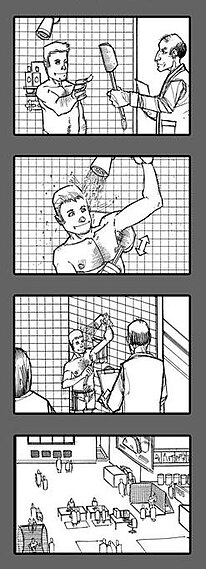Thriller is a genre of literature, film, and television that uses suspense, tension, and excitement as the main elements. The primary subgenre is psychological thrillers. After the assassination of President Kennedy, political thriller and paranoid thriller films became very popular.
The brightest examples of thrillers are the Hitchcock’s movies.The cover-up of important information from the viewer and fight/chase scenes are common methods in all of the thriller subgenres, although each subgenre has its own characteristics and methods.
Common methods in crime thrillers are mainly ransoms, captivities, heists, revenge, kidnappings. More common in mystery thrillers are investigations and the whodunit technique. Common elements in psychological thrillers are mind games, psychological themes, stalking, confinement/deathtraps, horror-of-personality, and obsession.
Elements such as conspiracy theories, false accusations, paranoia, and sometimes action are common in paranoid thrillers. some argue, though, that the thriller genre is simply a pseudonym for the horror genre, both using suspense and atmosphere to cause feelings of dread in their audiences.
"Homer's Odyssey is one of the oldest stories in the Western world and is regarded as an early prototype of the thriller." A thriller is villain-driven plot, whereby he presents obstacles that the hero must overcome.
The thriller genre can include the following sub-genres, which may include elements of other genres:
- Conspiracy thriller: In which the hero/heroine confronts a large, powerful group of enemies whose true extent only he/she recognizes.
- Crime thriller: This particular genre is a hybrid type of both crime films and thrillers that offers a suspenseful account of a successful or failed crime or crimes.
- Disaster thriller: In which the main conflict is due to some sort of natural or artificial disaster, such as floods, earthquakes, hurricanes, volcanoes, etc., or nuclear disasters as an artificial disaster.
- Legal thriller: In which the lawyer-heroes/heroines confront enemies outside, as well as inside, the courtroom and are in danger of losing not only their cases but their lives.
- Mystery thriller: Suspense films where characters attempt solving, or involved in, a mystery.
- Political thriller: In which the hero/heroine must ensure the stability of the government that employs him.
- Psychological thriller: In which (until the often violent resolution) the conflict between the main characters is mental and emotional, rather than physical.
- Supernatural thriller: In which the film brings in an otherworldly element mixed with tension, suspense and plot twists.

Although most thrillers are formed in some combination of the above, there are some however that are formed with other genres, which commonly are the horror genre, spy genre and the action/adventure genre.




